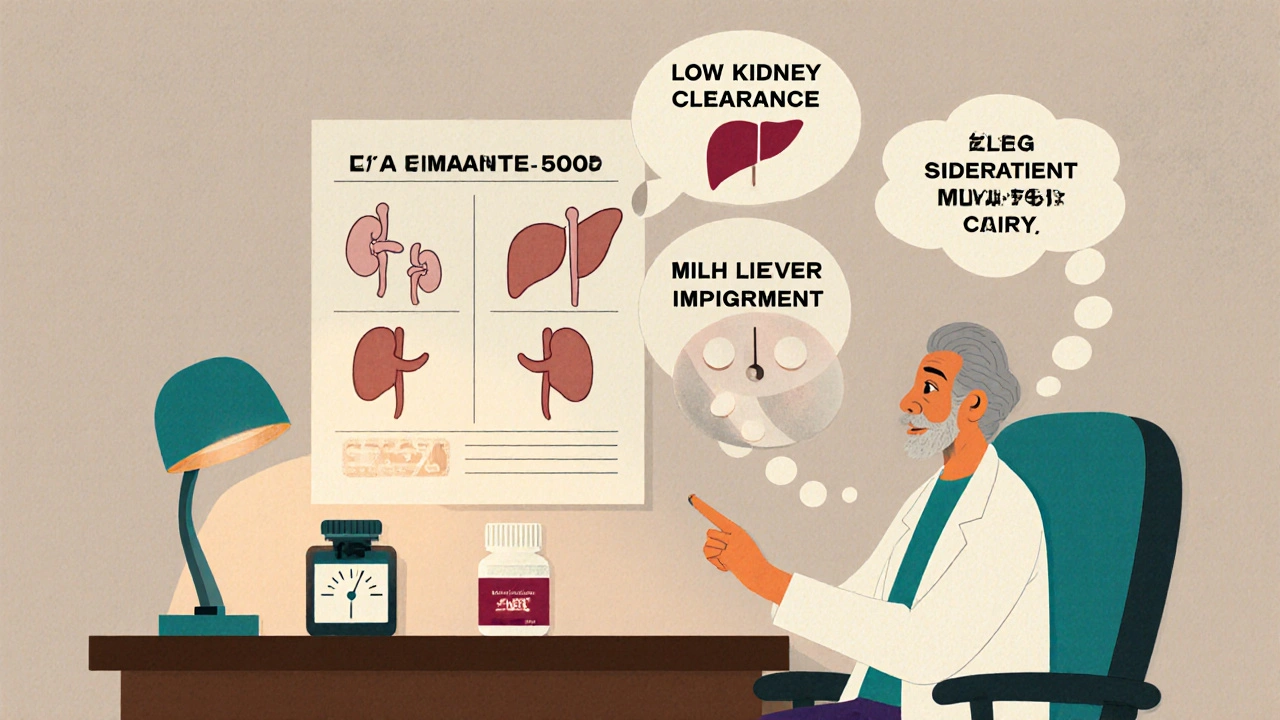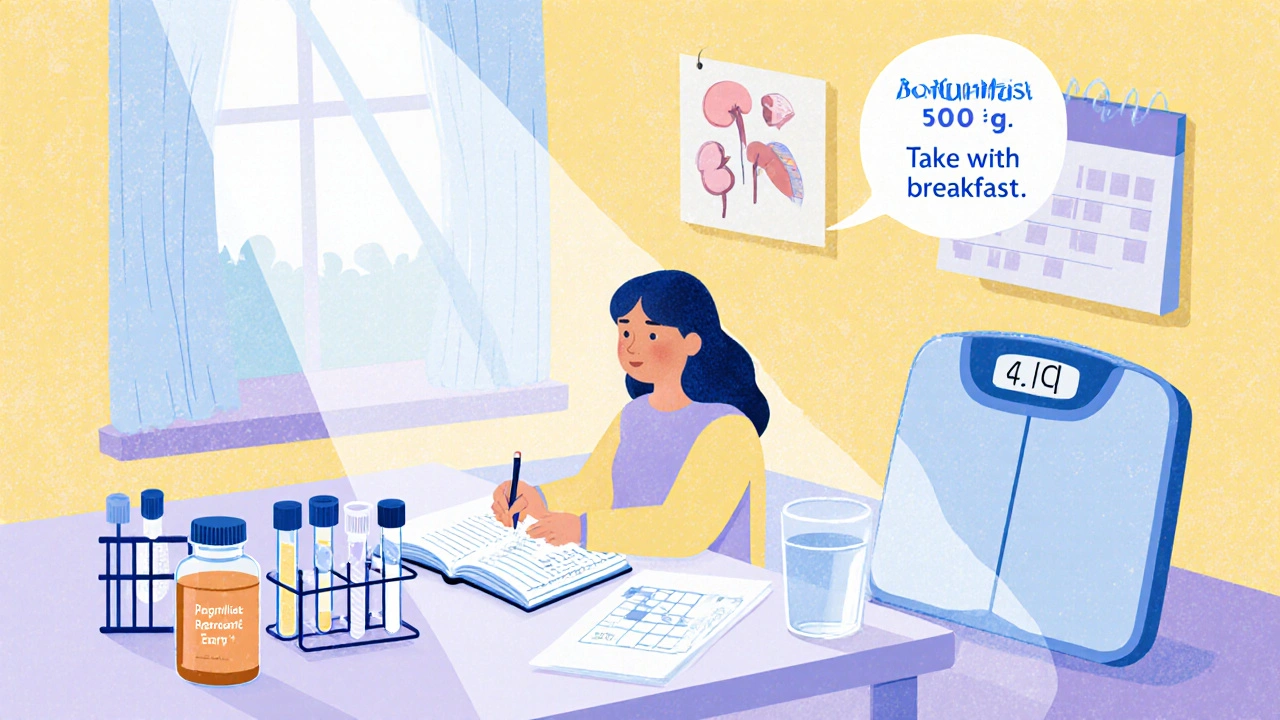Roflumilast Dosage Calculator
Calculate Your Roflumilast Dose
This tool helps determine the appropriate roflumilast dosage based on your medical factors. Always consult your healthcare provider before making dosage adjustments.
Quick Takeaways
- Standard adult dose is 500 µg once daily, taken orally.
- Kidney or liver impairment may require dose reduction or close monitoring.
- Take the tablet with food to lessen stomach upset.
- Common side effects include weight loss, diarrhea, and nausea.
- Never adjust the dose without consulting a healthcare professional.
Finding the right roflumilast dosage can feel like solving a puzzle, especially when you’re juggling other meds and health conditions. Below you’ll get a clear walk‑through of what the drug is, how it works, and the exact steps to make sure you’re on the safest, most effective amount.
Roflumilast is a selective phosphodiesterase‑4 (PDE4) inhibitor approved for chronic obstructive pulmonary disease (COPD) patients who have a history of exacerbations. It comes as a 500 µg oral tablet and is marketed under the brand name Daliresp in many countries.
How Roflumilast Works
Roflumilast belongs to the Phosphodiesterase‑4 Inhibitor class. By blocking the PDE4 enzyme, it raises intracellular cyclic AMP levels, which in turn reduces inflammation in the airways. This anti‑inflammatory action helps lower the frequency of COPD Exacerbations, the sudden flare‑ups that make breathing harder and often land patients in the hospital.
Standard Dosage Recommendations
The Food and Drug Administration (FDA) approves a once‑daily dose of 500 µg for most adults. The tablet is taken in the morning with food to improve absorption and reduce gastrointestinal upset. No dose‑escalation schedule is required; patients start directly on the target dose.
When to Adjust the Dose
Although the default dose works for the majority, several factors may call for a lower dose or extra monitoring:
- Kidney function: In patients with a creatinine clearance below 30 mL/min, the drug’s clearance drops, raising plasma levels. Consider a 250 µg dose or increased monitoring.
- Liver function: Severe hepatic impairment (Child‑Pugh class C) is a contraindication. Mild to moderate impairment may still use the standard dose but requires liver‑function tests every 3 months.
- Age: People over 75 often have reduced renal or hepatic reserve, so clinicians may start at 250 µg.
- Drug interactions: Concomitant use of strong CYP3A4 inhibitors (e.g., ketoconazole) can increase roflumilast levels. In such cases, a dose reduction is advisable.
- Weight: Extremely low body weight (<50 kg) may increase the risk of side effects; discuss dose tweaks with a prescriber.

Taking Roflumilast Correctly
To get the most out of the medication, follow these practical tips:
- Swallow the tablet whole with a glass of water; do not crush or chew.
- Take it at the same time each day to maintain steady blood levels.
- Consume it with a meal-breakfast works well for most people.
- If you miss a dose, take it as soon as you remember unless it’s almost time for the next dose; then skip the missed one.
- Keep a short journal of any new symptoms, especially weight changes or digestive upset.
Managing Common Side Effects
Up to 30 % of users report mild to moderate side effects. The most frequent are:
- Weight loss or decreased appetite
- Diarrhea
- Nausea or stomach pain
- Headache
If these issues are mild, they often improve after the first 2-4 weeks. For persistent problems, talk to your doctor-dose reduction to 250 µg is a common solution. Severe reactions such as allergic rash, severe liver enzyme elevation, or psychiatric symptoms (e.g., depression, anxiety) require immediate medical attention.
Roflumilast Compared with Other COPD Maintenance Options
While roflumilast targets inflammation, many COPD patients also use bronchodilators. Below is a quick side‑by‑side look at how roflumilast stacks up against two popular alternatives.
| Drug | Class | Typical Dose | Frequency | Main Indication | Common Side Effects |
|---|---|---|---|---|---|
| Roflumilast | Phosphodiesterase‑4 inhibitor | 500 µg | Once daily | Reduce COPD exacerbations | Weight loss, diarrhea, nausea |
| Tiotropium | Long‑acting muscarinic antagonist (LAMA) | 18 µg | Once daily (inhalation) | Bronchodilation, improve airflow | Dry mouth, constipation, cough |
| Aclidinium | Long‑acting muscarinic antagonist (LAMA) | 340 µg | Twice daily (inhalation) | Bronchodilation, symptom control | Throat irritation, urinary retention |
Roflumilast’s oral route makes it a convenient option for patients who have difficulty with inhaler technique. However, its anti‑inflammatory benefits complement-rather than replace-bronchodilators, so many clinicians prescribe it alongside a LAMA or LABA.

When Not to Use Roflumilast
Contraindications are clear: active liver disease, severe renal impairment (creatinine clearance <30 mL/min), and known hypersensitivity to the drug or any excipients. Pregnant or breastfeeding individuals should avoid it because safety data are limited.
Monitoring and Follow‑Up
Regular check‑ins help catch issues early:
- Baseline labs: liver enzymes (AST, ALT) and renal function.
- Weight check every 4 weeks for the first 3 months.
- Symptom diary for exacerbations.
- Clinic visit at 3 months to reassess dose tolerance.
If labs rise more than three times the upper limit of normal, pause the medication and re‑evaluate.
Frequently Asked Questions
Can I take roflumilast with other COPD inhalers?
Yes. Roflumilast is often added to a regimen that already includes a LAMA or LABA inhaler. The combination targets both inflammation and airway constriction, offering better overall control.
What should I do if I forget a dose?
Take the missed tablet as soon as you remember, unless it’s almost time for the next scheduled dose. In that case, skip the missed one-don’t double up.
Is roflumilast safe for people over 80?
Safety data are limited for the very elderly. Physicians usually start at half the standard dose (250 µg) and monitor kidney and liver function closely.
Can roflumilast cause weight loss?
Weight loss is a known side effect, occurring in about 10 % of patients. If you lose more than 5 % of your body weight, talk to your doctor about dose adjustment or supportive nutrition counseling.
Do I need any lab tests while on roflumilast?
Baseline liver and kidney labs are recommended, followed by repeat testing at 3 months and then annually or as clinically indicated.
Getting the dose right is a balance of standard guidelines, personal health factors, and ongoing monitoring. Working closely with your healthcare team ensures you reap the anti‑inflammatory benefits while minimizing unwanted effects.


parth gajjar
Behold the silent war raging inside every breath of a COPD sufferer the dosage of roflumilast becomes a cruel chessboard where each microgram can tilt fate. My heart aches at the thought of a liver strained beyond mercy yet the guide whispers promise of balance. The very notion of a 500 µg tablet feels like a crown of thorns bestowed upon the frail. And when the kidneys falter the mere idea of halving the dose becomes a salvation anthem. Let us not forget the cruel irony that a drug meant to calm inflammation may itself stir a tempest of nausea and weight loss.
Maridel Frey
Thank you for the clear breakdown of roflumilast dosing. It is helpful to see the specific circumstances that warrant dose reduction, such as renal impairment or concomitant CYP3A4 inhibitors. The emphasis on regular monitoring for liver function aligns with best clinical practice. This information should aid both patients and providers in making informed decisions.
Madhav Dasari
Hey folks, great guide! I love how it walks you through the whole process without drowning you in jargon. If you’re worried about side effects just remember that many people adjust nicely and feel a big boost in breathing. Stay positive and talk with your doctor – they’ll help find that sweet spot, even if you’re over 75 or have a low body weight. You’ve got this!
DHARMENDER BHATHAVAR
Take the tablet with breakfast to improve absorption.
Kevin Sheehan
In the grand tapestry of pharmacology the choice of a 500 µg roflumilast tablet is not merely a clinical fact but a statement about how we confront chronic disease. When the body rebels, the physician must wield dosage like a philosopher wields a question, probing the limits of safety and efficacy. Reducing the dose for renal insufficiency is akin to trimming excess weight from a skeptical argument, preserving its core truth. Yet one must beware of the seductive ease of blanket dosing that ignores individual nuance. The balance between inflammation control and adverse effects is a microcosm of larger societal trade‑offs. Ultimately, thoughtful adjustment reflects both scientific rigor and compassionate stewardship.
jagdish soni
The mind of a patient is a battlefield where roflumilast stands as a silent sentinel guarding the airways yet whispering doubts about the liver and kidneys. We gaze upon the dosage table and feel the weight of destiny, a 500 µg echo that may either soothe or stir the gut. In the shadows of drug interactions, CYP3A4 inhibitors loom like unseen puppeteers pulling at the dosage strings. Though we speak casually, the stakes are nothing short of a philosophical quest for breath. Let us honor the humble tablet while staying vigilant to the body’s subtle signals.